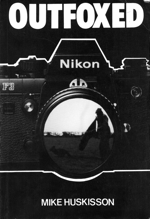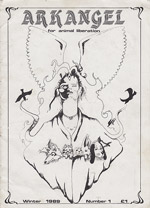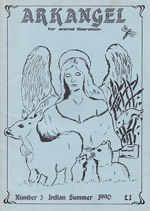» Next Entries
The Archives
-
Periodicals
Combat #1
07.10.11 | PermalinkCombat #1 (1990, Edmonton, Alberta, Canada)
After 6 years of operation in Toronto, a lull in activity caused the ALF Supporters Group Canada to shut down. Other volunteers picked up the slack and soon the SG was moved to Alberta. At this time the ALF was fairly active in the great white north, and soon their night time activities were being covered in a new magazine known as Combat. Considered by many to be the predecessor of Underground, Combat closely followed the template for supporters group publications set by The SG in England with one important difference: They had awesome cover art!
Combat is amongst the most rare militant animal rights publications produced in North America, and when we received this first issue for scanning we were delighted to find, a long, and thoughtful prison letter from Ronnie Lee, updates on the arrests of Jonathan Paul, Bill Keogh, and Cres Velluci, and a short listing of international action reports. There was also a hastily added pamphlet stuffed inside with an update on the jailing of Henry Hutto, an early movement hero who was amongst the first members of both PETA and Earth First! Very little information is available about Henry, who passed away in 2003, but he is a minor legend in some circles and the pictures of a rally held in his honor made holding this magazine that much sweeter.
Issue #2 of Combat is now available HERE.

…
-
Books
Outfoxed
07.01.11 | PermalinkOUTFOXED (1983, Mike Huskisson, London, England)
After participating in a series of high profile actions, including the famous “smoking beagles” liberation, early animal rights activist Mike Huskisson went on to pioneer the field of investigations into abuse and torture. Outfoxed was the product of that first investigation. It remains an important documentation of the early days of our movement and the type of undercover work that makes groups such as Mercy for Animals so prominent today. Conflict Gypsy is proud to share this classic, complete with a new introduction from the author.
My book Outfoxed is primarily an account of my undercover work for the League Against Cruel Sports to expose the cruelty inherent in the bloodsports of fox hunting, stag hunting, hare hunting, mink hunting and hare coursing in England over a two year period from April 1981 to May 1983. Outfoxed was written immediately after the investigation ended and published before the end of that year. At the time it was quite a novel idea to join the world of hunting, a pastime that the author wholly opposed, simply in order to film, photograph and report the cruelty that occurred so as to bring that cruelty to the attention of the outside world.
This was all in a different age. It was before video cameras and hidden cameras. The movie film that was taken during this investigation was taken with a Super-8 mm cine camera. This meant the sequences were limited to just a few minutes each before the film had to be turned over. All filming had to be done in good light. The highest quality of lens was chosen in preference to having sound.
The film cameras were exactly that – 35mm Nikon film cameras. Unlike modern digital cameras you took 36 images on a single film and then had to change your film. There was no opportunity to immediately preview your images to check the quality. You chose your film and the ASA setting for it and that was that for the whole film; there was no opportunity, as there is with modern cameras, to change the film speed settings from image to image. There was also no built in flash.
Finally, this investigation was carried out before the day of the mobile phone and the hand-held GPS device. When I was in the field with the hunting fraternity I was on my own. There was no opportunity to nip behind a hedge and make a secret call for back-up, or send a text message. If my opponents worked out who I really was and sought to take me to task I would have to talk my way out of it or else! If I needed to call for help I had to find a phone box. To know exactly where I was I had to be map-aware.
Before I carried out the investigation and wrote the book I had on several occasions been in trouble with the law for animal rights activity and had been imprisoned. The investigation and subsequent book was a plea to colleagues to see that animal rights could be advanced effectively entirely lawfully. I did not want then and do not want now to see kind compassionate people imprisoned. We can beat the animal abusers and bullies by using brains rather than brawn and by acting always within the law. It is the animal abusers who should be imprisoned not those who seek to protect life.
By showing the world what our opponents get up to, the barbaric way in which they use and abuse animals when they think they are out of sight, we really can generate the public anger that can force an end to these cruelties.
Knowing that Outfoxed was about to be published the hunting fraternity made all manner of threats that they would take libel action against the author and publisher. In the event to this day I have not received so much as a single letter of complaint as to the truth of anything that I wrote. After publication and following extracts being printed in the News of the World I did receive a letter from a young girl saying that when she was photographed at one of the hunts she had been raised by her parents to enjoy hunting but with growing older she had distanced herself from the pastime and was actually now working to improve animal welfare. Curiously in subsequent years some of the hunting people that I had befriended and infiltrated also told me, strictly off the record of course, that my account was a very factual record of hunting and one Hunt Master even asked me for a copy of my book!
Some of the pictures that I took during the investigation that were published in Outfoxed were widely published by the media at large including the likes of Stern magazine and the National Geographic Magazine.
All the bloodsports that I exposed in the course of my investigation were subsequently banned in England by Parliament through the Hunting Act 2004.
I now run my own campaigning animal welfare group: the Animal Cruelty Investigation Group. This was set up in June 1989 to fund the expenses of investigation work. You can find our web site at: www.acigawis.co.uk
Mike Huskisson,
Suffolk, England February 25th 2011
e-mail: acig@btinternet.com

…
-
Books
Animal Warfare
06.12.11 | PermalinkAnimal Warfare (1989, David Henshaw, London, England)
Based upon a television show of the same name, Animal Warfare was one of the first books written about the rise of animal liberation militancy. Its author, David Henshaw, is decidedly anti-animal rights, and at times his coverage is so unfair and deceitful that it’s tempting to write this publication off as mere tabloid journalism. That would be a mistake. While clearly written from the perspective of a person intent on smearing activists, this paperback also provides us with a look at our history less slanted by movement propagandizing and cheerleading. At times that picture is not pretty.
Authored during the rise of what some English activists called “the cult of militancy,” Animal Warfare takes the fodder provided by the most extreme actions of the early 80s and spins an ugly tale of car-bombs, poisoning hoaxes, graveyard desecration, and alliances with racist organizations such as the National Front. While there are plenty of grotesque distortions of facts, there are also valuable lessons to be learned about how the best tactical decisions consider our movement’s ability to survive backlash while building mass.
At a time when many modern activists seem intent on repeating the mistakes of the past, (or at least blogging as if they intend on repeating those mistakes), Animal Warfare contributes to our ability to learn about media falsification, the dangers of militaristic posturing, and the events which led to the weakening of England’s mass militant movement for animal liberation.
…
-
One-off publications
Keep Fighting: Three Interviews with Britain’s Animal Liberation Front Press Officers
05.20.11 | PermalinkKeep Fighting: Three Interviews with Britain’s Animal Liberation Front Press Officers (1996, Minneapolis, MN. USA.)
“In two buildings you have a number of dogs, and these dogs are being cruelly treated by humans. Another team of humans sledge hammer the doors down, go in, rescue the dogs, and take them to safety. In the first instance it is an old house and it’s an illegal dogfight and the team who sledge hammered the door are members of the RSPCA special investigation department and the local police…
In the second scenario, it’s a research laboratory and the dogs are beagles, and the humans who sledge hammered the door down are ALF activists….
Now I or someone else can argue until doomsday the rights and wrongs of legislation, but what it boils down to is until someone can explain the difference in the law to the dogs themselves, either both actions are morally right or both actions are morally wrong.”
-Robin Webb
Before Freeman Wicklund denounced tactics declared off limits by the state, he produced this fantastic little zine containing three highly influential interviews with Robin Webb, Ronnie Lee, and Robin Lane. Upon its release in 1996 copies of Keep Fighting were everywhere, and there was a noticeable increase in the quality of discourse on illegal direct action.
The arguments made in this booklet are convincing, and easily comprehensible but not simplistic. Your average, caring person without a masters degree or years of familiarity with activist verbiage can readily take the ideas discussed and share them with others, and many people did. We are happy that the face of underground resistance presented in Keep Fighting- intelligence, compassion, and a willingness to take risks for the benefit of others- is now accessible again for a new generation to read and share.
…
-
One-off publications
The Liberator
04.27.11 | PermalinkThe Liberator (1988, San Bernadino, CA. USA.)
In the 1970s, a small group of activists in England decided that animal abuse was so intrinsic to their society, and so protected by the courts and law enforcement, that anonymous, illegal activity was the only surefire way to directly prevent the horrors taking place in slaughterhouses, labs, and killing fields. They began to take the personal initiative to raid and sabotage places where the victimization of animals occurred, but how could they spread their message and tactics? With mainstream media treating them either as misguided nutcases or vicious criminals, and with national animal organizations disavowing their actions, they needed a mechanism to defend their tactics and share their views. The answer was the Animal Liberation Supporters Group, more commonly known as “The SG.” The SG soon took on the responsibility of printing newsletters, conducting press interviews, and raising funds and support for imprisoned activists. Soon, other supporters groups blossomed internationally, and eventually one took off in a small town in Southern California.
The Liberator was a publication of the Animal Liberation Front Support Group of America, an organization with a storied history that included FBI harassment, raids, and internal conflict. This inaugural issue was largely produced by Rod Coronado and Todd Meszaros, and the aesthetics of the issue reflect a bit of the punk influence that the two of them embraced. The design is busy, but also packed with information, press clipping, letters, debates, a timeline of US actions, and historically important letters from figures such as ALF co-founder Ronnie Lee. The centerfold is gorgeous, and it, and many of the other images contained inside were heavily borrowed and reprinted by other magazines.
The mission of the ALF SG of America was to vocally support and defend the ALF, to unify supporters of underground animal activism, to educate the public as to need and rationale of direct action, to encourage implementation of clandestine tactics, to provide a legal defense fund for imprisoned or arrested ALF activists, and to raise funds for all of the above. They did this at a time when dozens of labs across the country were being raided, thousands of people were protesting for animal rights, and the US seemed to be on the cusp of a mass movement for non-humans. The Liberator documented these efforts and is a classic piece of animal liberation history.
…
-
Arkangel, Periodicals
Arkangel #1-3
03.14.11 | PermalinkWelcome to the first three issues of the influential British publication, Arkangel. We’ll be posting more of these in the future.
Ronnie Lee was kind enough to write an introduction for their re-release on TALON. We accidentally bumped into him online while emailing the UK ALF Supporters Group asking for back issues of newsletters, and were heartened to see that one of the grandfathers of the direct action movement is still involved with activism and outreach.
“The idea for Arkangel came to me in 1989 while I was serving a 10 year prison sentence for involvement with the Animal Liberation Front. I thought it was important for there to be a magazine which provided news coverage of all aspects of the animal protection movement (public education, political campaigning, direct action etc.) from a radical perspective and which also provided a forum for rational debate/discussion.
Vivien Smith, whom I had previously worked with in publishing the ALF Supporters Group newsletter, had recently been released from prison and we teamed up again to produce the first issue of Arkangel, with me doing most of the writing and Viv typing it out and putting it together with artwork to create the magazine.
The second issue was produced in a similar fashion but, after that, everything had to change, as the prison stopped me from sending out articles, following complaints from the vivisection industry, and Viv was put in prison again for ALF actions.



…
-
Books
Against All Odds
03.14.11 | PermalinkOriginally published in England as a book 25 years ago, Against All Odds was regularly distributed in North America as a low cost zine. It remains one of the best publications documenting the rise of the Animal Liberation Front and the Animal Liberation Leagues in England.
In many ways, the 1980s was the high water mark of the Animal Liberation movement. In 1984, thousands of people in England participated in direct action against vivisection, staging large scale raids against six labs. Multitudes of people would overwhelm security in broad daylight and remove the oppressed creatures inside, often causing minor damage along the way and taking out valuable footage which was used to grow the movement. Many dozens of arrests followed these raids, but it is arguable that police response was not the cause of death of this mass militant movement taking shape in the UK.
Around this same time we saw the emergence of groups such as the Hunt Retribution Squad and Animal Rights Militia. Rather than rejecting the idea that animal rights activists were fanatics, HRS and ARM embraced that term and reveled in the negative imagery presented by the media. The Hunt Retribution Squad went so far as to release images of masked activists wielding clubs, chainsaws, and even pavement cutters. The front pages of newspapers widely reported on threats made by HRS to harm hunters if they attacked human opponents of hunting. In the end these counter-assaults never took place, but the damage was done. This type of macho posturing was repellent to many in the movement, and it provided great fodder for the police, courts, and conservative PR teams to use in the war against direct action. Certainly, the few acts of violence taken by the Animal Rights Militia could not outweigh the value of the mass raids and rising public consciousness taking place at the time, and contributed to the recession of a growing struggle for non-human emancipation.
Written in accessible language and unafraid of nuance, its tactical analysis and historical documentation remain valuable to this day. Against All Odds is essential reading for the modern animal liberationist.
…
» Next Entries








